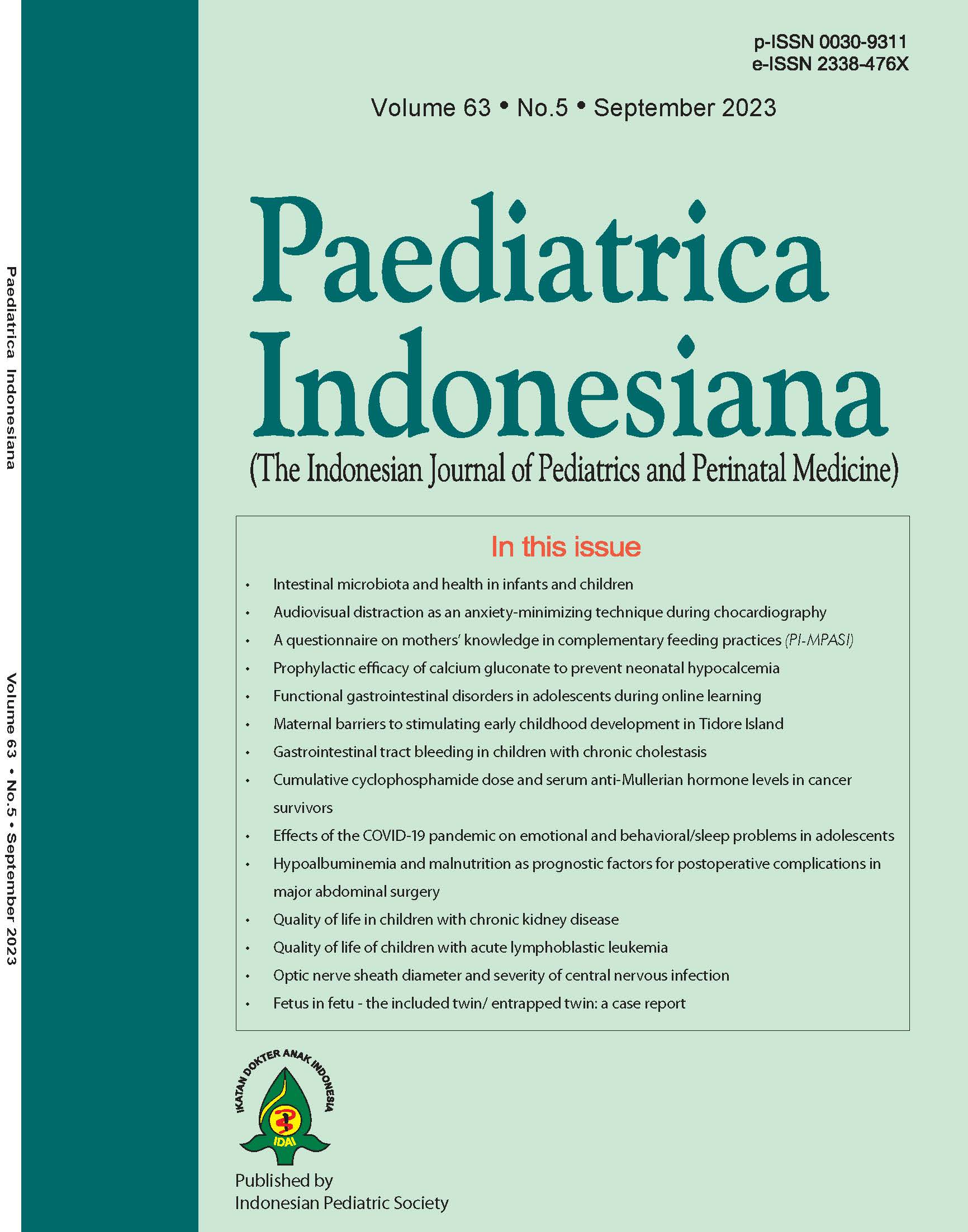The efficacy of audiovisual distraction as an anxiety-minimizing technique during echocardiography in preschool children
DOI:
https://doi.org/10.14238/pi63.5.2023.328-34Keywords:
echocardiography, children, distraction, anxietyAbstract
Background Echocardiography procedures can cause fear and anxiety in children, especially at preschool age. Audiovisual distraction is a simple, harmless, and low-cost technique that does not interfere with the procedure.
Objective To assess the effect of audiovisual distraction on the anxiety levels of children aged 2-5 years during echocardiography.
Methods This quasi-experimental study included children aged 2-5 years who were admitted for echocardiography. Patients with hearing or visual impairment, Down syndrome, autism, or attention-deficit/hyperactivity disorder were excluded. We administered anxiety-reducing intervention in the form of cartoon audiovisual media shown on a ceiling-mounted television during the echocardiography procedure. Anxiety levels were assessed using the Visual Analogue Scale - Anxiety (VAS-A) before and after the intervention was given. We compared the subjects’ pre- and post-procedure VAS-A scores and heart rates.
Results Of the 43 subjects who underwent echocardiography during the study period, the mean age was 3.2 (SD 0.9) years, with an equal sex distribution. Most subjects had a history of repeated echocardiography procedures and hospitalizations. Thirty-nine (90.6%) of subjects demonstrated anxiety during the echocardiography procedure. There was a significant mean difference of 11.9 (SD 13.2) bpm (95%CI 7.8 to 15.9 bpm, p<0.001) in heart rate pre- vs. post-intervention. Median pre- and post-intervention VAS-A scores were 5 (range 0-10) and 1 (range 0-4), respectively (P=0.001). Post-intervention, almost all (97.7%) subjects had no or mild anxiety.
Conclusion Audiovisual content presented on television serves as an effective distraction method to reduce children's anxiety during echocardiography.
References
2. Benavidez OJ, Gauvreau K, Jenkins KJ, Geva T. Diagnostic errors in pediatric echocardiography: development of taxonomy and identification of risk factors. Circulation. 2008;117:2995-3001. DOI: https://doi.org/10.1161/CIRCULATIONAHA.107.758532.
3. Sánchez Ferrer F, Grima Murcia MD, Lopez-Pineda A, Juste Ruiz M, Orozco Beltran D, Carratala-Munuera C, et al. Effects of watching cartoons during an echocardiography on infants and preschool children. A prospective randomized study. Front Pediatr. 2019;7:184. DOI: https://doi.org/10.3389/fped.2019.00184
4. American Academy of Pediatric Dentistry. Behavior guidance for the pediatric dental patient. The Reference Manual of Pediatric Dentistry. Chicago, Ill.: American Academy of Pediatric Dentistry; 2021. p. 306-24.
5. Heistein LC, Ramaciotti C, Scott WA, Coursey M, Sheeran PW, Lemler MS. Chloral hydrate sedation of pediatric echocardiography: physiologic responses, adverse events, and risk factors. Pediatrics. 2006;117:434-41. DOI: https://doi.org/10.1542/peds.2005-1445.
6. Custodio NB, Cademartori MG, Azevedo MS, Mendez MA, Schardozim LR, da Cosra LR, et al. Efficacy of audiovisual distraction using eyeglasses during dental case: a randomized clinical trial. Braz. Oral Res. 2021;35:e026. DOI: https://doi.org/10.1590/1807-3107bor-2021.vol35.0026.
7. Zakhary SA, Eid MH, Wassef NM. Audiovisual distraction effect on heart rate in children during dental treatment, a randomized clinical trial. Egypt Den J. 2020;66:28-34. DOI: https://doi.org/10.21608/EDJ.2020.77496.
8. Guinot F, Mercade M, Oprysnyk L, Veloso A, Bof JR. Comparison of active versus passive audiovisual distraction tools on children’s behaviour, anxiety and pain in paediatric dentistry: a randomized crossover clinical trial. Eur J Paediatr Dent. 2021;22:230-6. DOI: 10.23804/ejpd.2021.22.03.10
9. Setiawan AS, Zidnia H, Sasmita IS. Mozart effect on dental anxiety in 6-12 year old children. Majalah Kedokteran Gigi. 2010;43:17-20. DOI: https://doi.org/10.20473/j.djmkg.v43.i1.p17-20
10. Molu B, Acikgoz A. A randomized controlled study: the effect of preprocedurals informative animation watch about echocardiography and intraprocedural kaleidoscope watch on anxiety in children. JPN J Nurs Sci. 2021;12468:1-13. DOI: https://doi.org/10.1111/jjns.12468.
11. Lim SH, Kim M, Lee M. Use of animated cartoons with children's songs to increase compliance with ultrasonography in young children. Yonsei Med J. 2013;54:1533–7. DOI: https://doi.org/10.3349/ymj.2013.54.6.1533.
12. Madueme PC, Arevalo A, Kudchadker N, Srivastava S. Segmental approach to performing a standard pediatric echocardiogram. Prog Pediatr Cardiol. 2020;58:1-38. DOI: https://doi.org/10.1016/j.ppedcard.2020.101260.
13. Choy Y, Stein MB, Friedman M. Acute procedure anxiety in adults. Course, screening, asseement, and differential diagnosis. Last update Mar 18, 2019. [cited 2022 Aug 30]. Available from: https://www.medilib.ir/uptodate/show/17123.
14. Lacquiere DA, Courtman S. Use of the iPad in paediatric anaesthesia. Anaesthesia. 2011;66:629–30. DOI: https://doi.org.10.1111/j.1365-2044.2011.06735.x.
15. Al-Hababi MN, Bshara N, AlNerabieah Z. Effectiveness of audiovisual distraction using virtual reality eyeglasses versus tablet device in child behavioral management during inferior alveolar nerve block. Anaesth Pain & Intensive Care. 2018;22:55-61.
16. Liu Y, Gu Z, Wang Y, Wu Q, Chen V, Xu X, et al. Effect of audiovisual distraction on management of dental anxiety in children: A systematic review. Int J Paediatr Dent. 2019;29:14-21. DOI: https://doi.org/10.1111/ipd.12430.
17. Dahlquist LM, Weiss KE, Clendaniel LD. Effects of video game distraction using a virtual reality type head-mounted display helmet on cold pressor pain in children. J Pediatr Psychol. 2009;34:574–84. DOI: https://doi.org/10.1093/jpepsy/jsn023.
18. Tsigos C, Kyrou I, Kassi E, Chrousos GP. Stress: endocrine physiology and pathophysiology. (Updated 2020 Oct 17; cited 2022 Aug 30). Available from: https://www.ncbi.nlm.nih.gov/books/NBK278995.
19. Facco E, Stellini E, Bacci C, Manani G, Pavan C, Cavallin F, Zanette G. Validation of visual analogue scale for anxiety (VAS-A) in preanesthesia evaluation. Minerva Anestesiol. 2013;79:1389-95. PMID: 23860442.
Downloads
Published
How to Cite
Issue
Section
License
Authors who publish with this journal agree to the following terms:
Authors retain copyright and grant the journal right of first publication with the work simultaneously licensed under a Creative Commons Attribution License that allows others to share the work with an acknowledgement of the work's authorship and initial publication in this journal.
Authors are able to enter into separate, additional contractual arrangements for the non-exclusive distribution of the journal's published version of the work (e.g., post it to an institutional repository or publish it in a book), with an acknowledgement of its initial publication in this journal.
Accepted 2023-10-26
Published 2023-10-26














